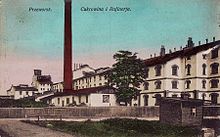Przeworsk
It also is an important railway junction, with trains going in three directions – east (towards Przemyśl), west (towards Rzeszów) and north (towards Stalowa Wola).
Przeworsk has some 60 historic buildings, including two fortified Gothic abbeys, a town hall, the Lubomirski Palace in classical style, a baroque monastery, and an open-air museum (skansen).
Soon Polish settlers came to the deserted border areas, and in November 1387, King Władysław II Jagiełło ceded Przeworsk to the Voivode of Sandomierz, Jan of Tarnow, Leliwa coat of arms.
Until the 18th century, Przeworsk was a private town of several Polish noble families, as it passed through Tarnowski, Ostrogski and Lubomirski ownership.
Przeworsk became the second largest town in the area after Przemyśl, prospering in the period known as, the Polish Golden Age.
Since Crimean Tatars often raided the southeastern Poland, and sometimes even reached its south-central parts, in 1510 the construction of ramparts was started.
The population began to grow, new housing was built, together with a monument dedicated to King Władysław II Jagiełło (1910), but World War I brought destruction to the town.
During the joint German-Soviet invasion of Poland, which started World War II, Germany conducted air raids on 3, 5 and 6 September 1939, in which several people were killed and many were wounded.
[3] Przeworsk was captured by the Wehrmacht on 9 September 1939, and then the Einsatzgruppe I entered the town to commit various atrocities against Poles.
During the Intelligenzaktion, on November 3, 1939, the Germans deceitfully gathered the local Polish intelligentsia for a formal meeting, then arrested 58 people and imprisoned them in Rzeszów.

